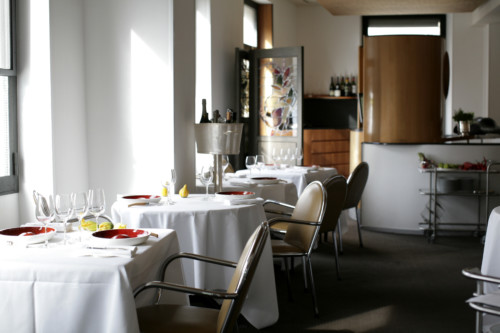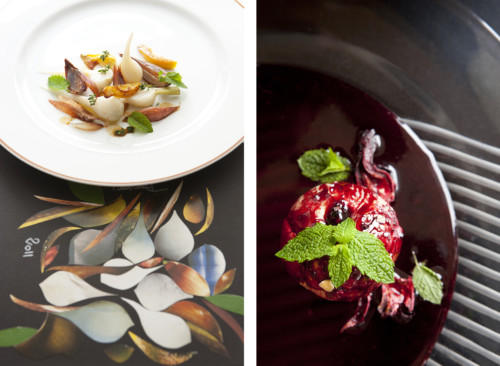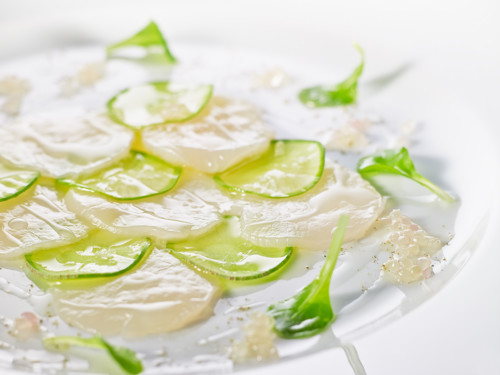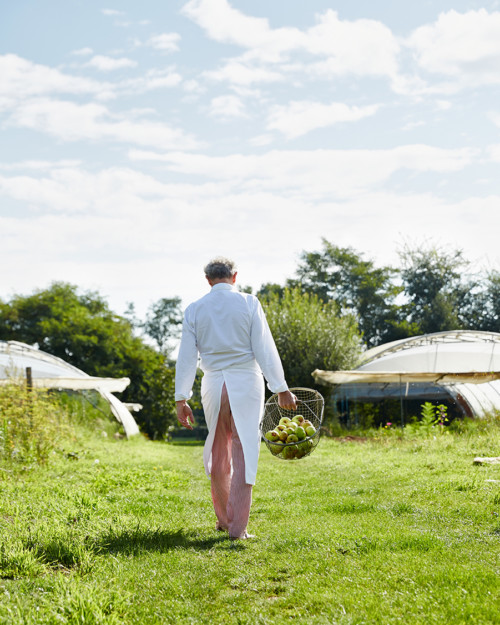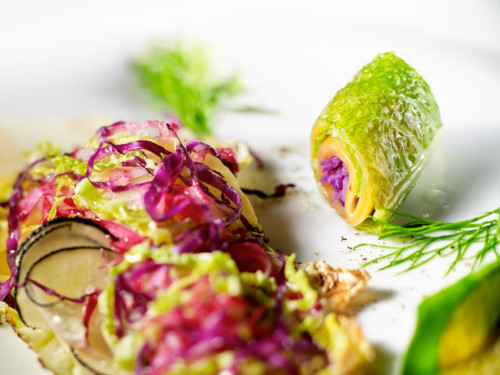
A Conversation with Alain Passard, Michelin-Starred Chef and Vegetable Lover
By age 14, Alain Passard already knew he wanted to be a chef. This is a dream that he obviously never abandoned, as he is now regarded as one of the best chefs in Paris. Today, he meets us for this interview in l’Arpège, his iconic Parisian restaurant just a stone’s throw from Les Invalides.
Trained by his grandmother, an excellent cook, and then by his mentor, Alain Senderens, the restaurant’s name is nod to his musician father and to one of his many leisure pursuits, the saxophone. L’Arpège (which means “arpeggio” in English) has resonated beautifully for 31 years, and through its kitchen’s instruments reminds us of the succession of flavors for which Passard has become known.
Triple Michelin-starred since 1996, Alain Passard is more than just a chef: charismatic, curious, and passionate, he is also an artist and poet, simultaneously conscious and committed to food. Since the year 2000, he has devoted himself to what he calls “the poor relations” of the kitchen: vegetables.
In his hands, they are respected and loved from the ground to the plate and transformed into “grands crus”, which can be eaten without moderation. Below, we speak to the chef about his culinary ethos, the art of “paring down gestures,” and his enduring love of seasons.
GC: How would you define your cuisine?
AP: I hope it’s still not defined! Besides, only an outsider could say one way or another, because it’s hard to define what you do, isn’t it? But if I had to talk about my cooking, I would say that it is simple cuisine, in the strong sense of the word– a cuisine where the hand of the chef is not too evident. My dynamic is more about paring down gestures and purity. Sometimes this is too simple for some people, but that’s how it is. My team and I have a lot of fun with our gardens. We have a much smaller range of flavors than some restaurants because, in a garden, each season generates between 20 and 25 flavors. By respecting this [natural cycle], we keep the most accurate expression of what nature can write in a vegetable garden. The menu changes according to the seasons, so you could say that we have four restaurants in one, because every 3 months it is like a new place.
“I try to make sure that the creativity I feel in the kitchen is also found in the garden, through nuances and subtleties.”
I like the idea of “seasons”. At my place there are no recipe books, which allows us to refine our senses. Our touch isn’t the same all year round; I don’t have the same touch in Spring as in Winter or Autumn, because the products are different. I don’t have the same touch with a tomato as with celeriac; aubergine doesn’t have the same taste as asparagus; and the aroma of peas is not the same as that of haricot beans. The same goes for the visual aspect because our sight isn’t the same all year round. What I find interesting is exactly that– having different images every 3 months and so developing my creativity.
The same applies to the ear: the sound of how a tomato cooks isn’t the same as for a beetroot. I think nature has created seasons precisely to avoid routine and leave room for passion in a cuisine that is regularly renewed.
GC: How did vegetables come to be your main focus?
AP: Having grown-up in a family of artists, including a grandfather who was a sculptor, I have always loved painting, collages… Color has always fascinated me and even today it is a very strong source of inspiration. So what does color mean in cooking?
It is the garden, the vegetables, fruit, herbs, flowers…Originally, l’Arpège was a rotisserie. People mainly came to me for meat; poultry, prime rib of beef, and so on. I finally got the impression that I had read the whole book on the subject and wanted to start a different one. Strangely, I rarely thought about vegetables. And people were even telling me that there weren’t enough vegetables! They only had a supporting role, as a sort of garnish. So in 1999 I opened the door to vegetables and in a way, that changed my whole career.
GC: Are vegetables what you enjoy working with the most?
AP: I really enjoy preparing them; even though I still enjoy cooking veal rump or poultry occasionally. Vegetables have different textures, like cloth, and colors, which, like a painter, help me to compose.
“Color has always fascinated me and even today it is a very strong source of inspiration. So what does color mean in cooking? It is the garden, the vegetables, fruit, herbs, flowers…”
GC: Not all chefs have their own kitchen garden, but you do. Why did you decide to grow your own vegetables?
AP: At our level, we are the only ones, yes. I always worked with market gardeners and I realized that I wanted to take vegetables further. I found the job of being a gardener fascinating and I became completely gripped by it. By recognizing the value of this quite artistic job, I wanted to give these men and women visibility, because they have real grace. I try to make sure that the creativity I feel in the kitchen is also found in the garden, through nuances and subtleties.
With these gardeners, twelve of whom work with me today, I wanted to rediscover what nature creates. Wanting to make grand cru vegetables inevitably meant having our own gardens because I wanted to be able to say, ‘I want such a tomato and such a green bean for such a recipe’. Just like I wanted to be able to say, ‘I want the green beans and peas picked like that’. I wanted to be able to place my own orders and know that behind everything, every product, there is a skill, an identity.
GC: What do you grow in your kitchen garden? You also have orchards, no?
AP: We are almost self-sufficient nowadays with nearly 12 hectares shared between Sarthe and Eure [rivers], which gives us an annual supply of about 60 tonnes of produce. 30 tonnes are for the restaurant and 30 tonnes are for individuals who buy “Le panier d’Alain”. So when the truck– sometimes even two!– arrives every day in front of L’Arpège, it’s a real ceremony! We try to always work with Kokopelli (an organization that offers organic, non-GMO, vegetable and herb seeds). As we save the seeds from one year to the next, we hardly buy anything now!
“I found the job of being a gardener fascinating and I became completely gripped by it… I wanted to give these men and women visibility, because they have real grace.”
At this time, in April, we are harvesting peas, asparagus and all the baby vegetables, such as turnips, beetroot, carrots, kohlrabi, cabbage, shallots and garlic, leaves like spinach and sorrel, as well as all the herbs– salad leaves, mesclun… In September, it is still summer, so we are harvesting tomatoes, courgettes, cucumbers, aubergines, peppers, and then all the fruit, peaches and figs. In December, on the other hand, it is all the roots, horseradish, salsify, scorzonera, beetroot, Jerusalem artichokes, and swede as well as truffles. Apart from our orchards facing the bay of Mont St. Michel, our gardens also grow fruit and berries. And when it’s over, it’s over– we move on to something else.
GC: Do you have a particular way of growing fruit and vegetables?
AP: The quality of a vegetable depends on where it is comfortable. This is why my gardeners and I carry out trials. The same seed is planted on the same day and at the same time in both types of soil. In the Sarthe, where the soil is very sandy and in the Eure, where it is very clay-like. We are working along the same lines as wine growers in that we will plant the vegetables that best correspond to the soil. In our gardens, the work is 100% natural and we do not use fertilizers or pesticides. But unfortunately, our neighbors don’t have the same ideas as us and they treat their fields! Fortunately, our land wasn’t too damaged. By working on the quality of our earth, our gardens have become dormitories, shelters for animals. We have managed to create, without the intervention of chemicals, a real ecosystem where fauna and flora coexist.
GC: What do you think of the way fruit and vegetables are grown in the Western world today?
AP: At my grandparents house, we only had tomatoes in early July. Soil-free didn’t exist at the time. After that, what next? Not to mention all the treatments that are used, so farmers manage to grow a mature tomato in 50 days. In our garden, it takes more than 5 months, with real light, proper photosynthesis… One former employee told me one day: ‘When you work at L’Arpège, it’s hard after working with tomatoes all year’.
GC: L’Arpège is not for everyone. How can you eat properly when you don’t have access to that sort of quality on a daily basis?
AP: What it comes down to is, we aren’t even talking about cuisine or gastronomy, we are talking about public health! Why? If you go into any upmarket grocery store, you’ll find everything at any time of the year. The consumer is totally confused!
GC: Which means what?
AP: It means that in the middle of Winter, consumers are cooling themselves down, instead of getting warmed up. A tomato is made to cool you down when it is 30° C. And in Winter, I warm myself up with what nature has put in the soil, such as cream of parsnip soup, a gratin of Jerusalem artichokes or celeriac soup… There are no more nuances, the fridge has the same things in it from January 1st to December 31st. The restaurants are the first ones at fault, as we shouldn’t serve tomatoes all year!
“There are always different ways to season and cook. Touch and gesture are part of the dance.”
We eat the same things all year, we have the same way of doing things all year, we have the same aromas, the same visuals, the same meaning… What happened to the idea of seasonality? To eat healthily is to go back, to find out what is in a garden at any specific moment. This is my struggle with the hotel schools; I’m asking them to hold courses on seasonality. Everyone’s doing it, and even pastry chefs don’t respect it anymore because we have strawberries all year round. They don’t know how to do anything else. And by continuing to buy, everybody supports it. In order for things to change, everyone has to get involved. Seriously.
GC: Who inspires you?
AP: I have a real respect for those who taught me everything. Veterans like Michel Kerever, Gérard Boyer, Gaston Lenôtre, and Alain Senderens. Those who taught me how to cook through concentration, perseverance, and rigor, because we get nothing without working.
GC: What do you think about American gastronomy and its evolution? Especially in New York and California?
AP: It’s changing more and more in the right direction. There are guys who have the same approach as me, like Dan Barber, in Hudson Bay, New York. This farmer-chef also puts vegetables centre stage and upsets the classic codes of gastronomy by imposing himself as a figurehead of what will be good for us tomorrow. He has also risen to the Top 10 of the 50 best restaurants in the world. Number one is also in New York, with Chef Daniel Humm of Eleven Madison Park. In San Francisco, we can also talk about the Frenchwoman Dominique Crenn and her restaurant, Atelier Crenn.
Americans are very worried about and sensitive to what they eat, and the provenance of the products. Numerous allotments are emerging everywhere in order to develop responsible, urban agriculture. But you also can’t ignore Chinese, Japanese, Moroccan, Italian, or Scandinavian cuisine. There are always different ways to season and cook. Touch and gesture are part of the dance.
L’Arpège is located at 84 Rue de Varenne in Paris.


























